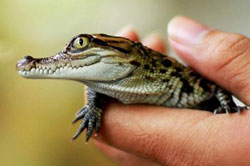Wildlife Conservation Society helps hatch rare Siamese crocodiles in Lao PDR

A recently hatched Siamese crocodile at the Laos Zoo, part of an effort by the government of Lao PDR and the Wildlife Conservation Society to replenish the wild population of this critically endangered species. Credit: M. Douangmyxay/WCS Laos Program<br>
Working with the government of Lao PDR, the Wildlife Conservation Society has helped to successfully hatch a clutch of 20 Siamese crocodiles, a species threatened across its range by hunting, habitat fragmentation and loss, and other factors.
Hatched from eggs taken from the wild and incubated at the Laos Zoo, the baby crocodiles represent a success for a new program that works to save the Siamese crocodile and the wetlands and associated biodiversity of Laos' Savannakhet Province.
The project is supported by the Savannakhet Province Agriculture and Forestry Office and MMG LXML Sepon.
“We're thrilled at the prospect of augmenting the wild population of Siamese crocodiles with a new batch of healthy juveniles,” said Chris Hallam, Conservation Planning Advisor for the Wildlife Conservation Society's Lao PDR Program and the crocodile project coordinator. “It's a small but important step in helping to conserve a valuable part of the natural heritage of Lao PDR for the benefit of future generations.”
Launched in 2008 as the Crocodile Resource Management Plan, the project uses crocodile conservation as a means of protecting the larger landscape. The first phase of the project focused on surveys of crocodiles, the wetlands where they occur, and the livelihoods of local communities in Savannakhet Province. Survey teams located small numbers of crocodiles in several sites in the province's river systems and wetlands.
The recently hatched eggs are part of the crocodile replenishment phase of the project, where eggs from wild nests are transported to captive settings in order to boost the survivorship of the clutches. The hatchlings will be released as second-year juveniles, when the reptiles are large and robust enough to avoid mortality in the wild.
The plan, say organizers, also relies on input and involvement from local communities, who will help promote the recovery of the Siamese crocodile and the habitat on which many livelihoods rely.
“This integrated project promotes the conservation of an entire landscape by highlighting the critical connections between an endangered species and local livelihoods,” said Joe Walston, Director of WCS's Asia Program.
Classified as Critically Endangered by the International Union for Conservation of Nature, the Siamese crocodile grows up to 10 feet in length. The species has been eliminated from much of its former range through Southeast Asia and parts of Indonesia by overhunting and habitat degradation and loss.
Media Contact
More Information:
http://www.wcs.orgAll latest news from the category: Ecology, The Environment and Conservation
This complex theme deals primarily with interactions between organisms and the environmental factors that impact them, but to a greater extent between individual inanimate environmental factors.
innovations-report offers informative reports and articles on topics such as climate protection, landscape conservation, ecological systems, wildlife and nature parks and ecosystem efficiency and balance.
Newest articles

High-energy-density aqueous battery based on halogen multi-electron transfer
Traditional non-aqueous lithium-ion batteries have a high energy density, but their safety is compromised due to the flammable organic electrolytes they utilize. Aqueous batteries use water as the solvent for…

First-ever combined heart pump and pig kidney transplant
…gives new hope to patient with terminal illness. Surgeons at NYU Langone Health performed the first-ever combined mechanical heart pump and gene-edited pig kidney transplant surgery in a 54-year-old woman…

Biophysics: Testing how well biomarkers work
LMU researchers have developed a method to determine how reliably target proteins can be labeled using super-resolution fluorescence microscopy. Modern microscopy techniques make it possible to examine the inner workings…





















